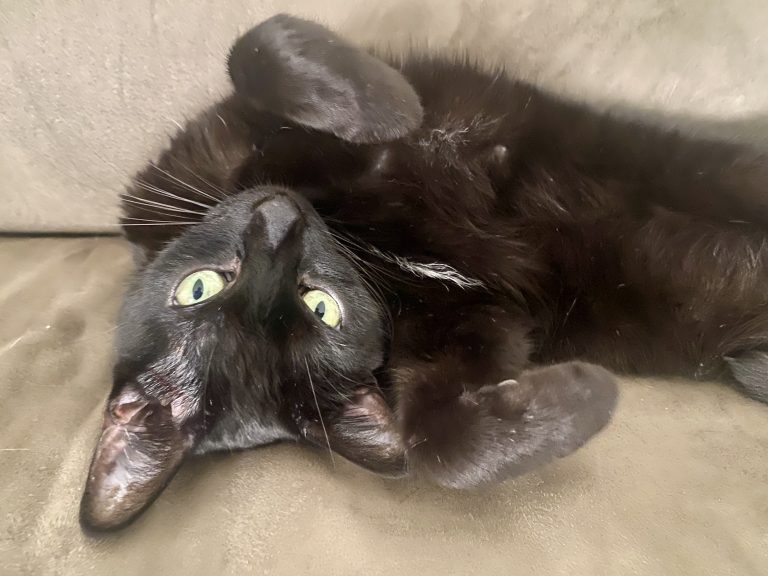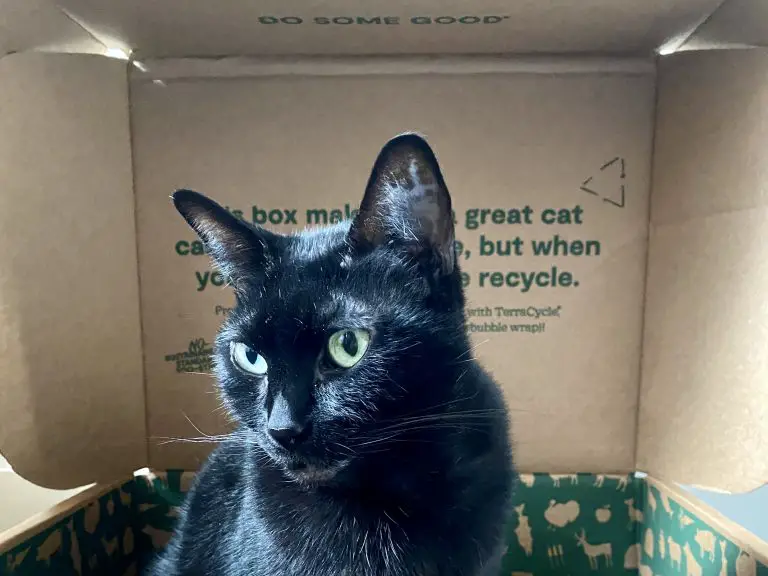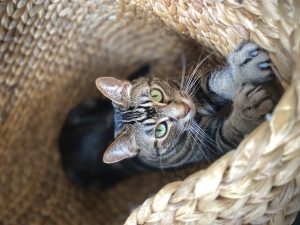The UnderCat: Why You Should Adopt a “Less Adoptable” Cat
If you’re about to get a cat, have you thought about adopting an “Undercat?” One that is less likely to find a home?
If not, you should. Here’s why.

The “Less Adoptable” Phenomenon
If you went to your local animal shelter today, chances are high you’d find several amazing cats there who have been waiting a long time to get adopted, and will probably wait even longer still. Day after day they are passed over while other “more adoptable” cats quickly find homes.
There’s often nothing about these cats that makes them actually less adoptable, and certainly not less deserving of having a good home. In reality, it’s because many people want to adopt either a kitten or a breed or color that is popular or perceived as more photogenic.
Little do they know, they are looking right past some real gems – sweet, loving, beautiful animals that will make truly wonderful pets if given the chance. Sadly, more than half of them never will get that chance.
The Cold Reality of the “Less Adoptable” Phenomenon
The saddest part is that it’s stressful for cats to be in a shelter for any length of time. And stress takes a toll physically and mentally for cats, just like it does for people. Quality of life is not good for shelter animals. What’s worse, because of limited space and resources, many shelters end up euthanizing animals that don’t get adopted within a certain time period.
The American Society for the Prevention of Cruelty to Animals (ASPCA) has estimated that, out of the 3.4 million cats that enter shelters every year in the United States, 1.4 million of them are euthanized. And the Humane Society of the United States has reported that about 80% of euthanized cats are healthy or treatable and would’ve made quite suitable companions. The numbers are similar in many countries around the world.
So, by adopting a “less adoptable” cat, you might literally be saving the cat’s life. And that cat may well have a lot of life left to live, and a lot of love to give all to you.
Which Cats Are Less Likely to Be Adopted?
Here are the cats that are most likely to be stuck in the shelter as other cats get chosen over them day after day:
- older cats
- black cats
- cats with disabilities, birth defects, traumatic injuries, or special needs
- Cats with medical conditions
- cats that seem shy, fearful, or withdrawn
- feral and unsocialized cats
This phenomenon may have intensified in recent years as social media drives a desire to post photos of trendy cats that photograph well and get more likes and comments.
Now let’s take each of the types of less-chosen cats one by one.
Older and Elderly Cats
Cats in this very broad category are more than 7 years old. Over 50% of these cats who enter a shelter will never be adopted, and will be euthanized. In contrast, over 80% of kittens in shelters find a home.
The majority of people looking to adopt a cat from the shelter are looking for a kitten or very young cat. It’s hard to blame them, honestly – there aren’t many things in the world cuter than kittens. But kittens don’t keep their kitten-cuteness for very long, they can be pretty destructive, and of course they all turn into older cats.
Therefore, it may be well worth it to consider a distinguished adult cat with some life experience!
5 Reasons to Consider Adopting an Older Cat
1. Older cats = more chill, less damage control. Skip the crazy-energy phase of a kitten climbing your curtains or chewing your charger cables every time you turn around. You also get to skip the litter-training part, because adult cats already know how to use the litter box.
2. Many available adult cats have a lot of life left to live – cats often live for 15-20 years. It is absolutely heart-breaking that the majority of euthanized cats are either perfectly healthy or very treatable. Imagine, a healthy 7-year-old cat losing her life because no one chose her to be their pet.
3. Adult cats’ personalities and characteristics are known quantities. With kittens, it’s a bit of a dice roll in terms of what they’ll be like as adults (which may turn out to be the type of cat you wouldn’t have chosen). When you adopt a seasoned fur pal, you’ll already have a much better idea of what you’re getting.
4. Integrating an adult cat into your home is simpler than it is when starting with a kitten. Kittens are disruptive and destructive, and they require more training and cat-proofing. They also need more supervision when added to a home with small children or other pets. If you’ve got kids or a dog or cat, you’ll probably be able to find an adult cat already experienced with kids and other pets. This will probably make the adjustment period with your new cat a lot more manageable.
5. Getting an older cat is a win-win proposition. You rescue a cat from a stressful setting and give it a good home. In return you gain a loveable animal in your family while knowing that you did an incredible act of good because you probably saved his life.
Black Cats and the “Black Cat Bias” Phenomenon
Black cats and cats with darker fur get adopted at lower and slower rates than other cats. Why? Some speculate that there is still stigma around black cats (https://humaneloudoun.org/what-is-black-cat-syndrome/) because of archaic notions that they are bad luck or bad omens.
Other reasons may include the tendency to use superficial judgments that black cats are less photogenic, or the possibility that people connect more quickly with cats with lighter coats in shelters due to the fact that shelters are typically poorly lit. This may result in dark-coated cats getting overlooked because people don’t notice as readily how cute they are.
A recent study suggested that “black cat bias” may not be quite as strong a phenomenon as some believe it to be, but it still showed that black and dark cats do fare worse than light-coated cats when looking at adoption and euthanasia rates.
This is obviously plain silliness, and you can use this knowledge when you go to the shelter and make sure that you aren’t overlooking any highly adoptable gems that others are passing over. Not only does a cat with a dark coat have just as much likelihood of being a great pet as any other cat, the act of adopting one may just be saving its life.
Why You Should Consider Adopting a Black Cat
Black cats are just as wonderful as any other cat as far as personality and temperament go. And they’re gorgeous animals! They look like miniature panthers. Just have a look at my cat, Bean, for example.

Yep, she’s pretty great. While I’m at it, here’s a little more about Bean. Not only is she beautiful, but she is one of the sweetest, most easy-going cats I have ever known. And that’s saying something. Almost every day, there’s a small window of time where she is hyper-affectionate, and she will follow me literally wherever I go in the house, wanting to be picked up and snuggled.
Thousands of cats just like Bean are euthanized at shelters across the country every month because no one chose them.
If good photos are truly a concern, all you have to do is learn a little extra about how to use light in your pet photography, and your instagram will be overflowing with stunning photos of your beautiful black cat. Just google “tips for photographing pets with black fur.”
Shy, Withdrawn, and Timid Shelter Cats
Most people looking to adopt a cat are naturally drawn to the most outgoing and friendly cats at the shelter. And they tend to quickly dismiss any cats that may appear shy, standoffish, withdrawn, or depressed.
Why You Should Consider the Shy Cats
It’s important to keep in mind that first impressions may not capture a cat’s true personality. Especially when you haven’t even spent any time with the cat outside of the cage it’s trapped in. Being in a shelter is extremely stressful for most cats. Who could blame a cat for huddling in the corner?
Find out which staff member knows the cat the best. It can pay off to ask questions about whether the behavior you’re seeing really reflects the way the cat is around people it already knows and trusts a little bit. You can also find out what is known about the cat’s background and health.
Likewise, you are likely to see more of a cat’s true nature when you make visits across multiple days, multiple times of day, and spend time with it outside of the cage where it can get to know you on more of its own terms. Ask if there’s a designated room or space where you can interact freely with a cat for 20-30 minutes.
Things to Avoid
1. Dismissing Available Cats Too Quickly
Don’t automatically dismiss cats that don’t seem happy or energetic. Remember that the adult cats you see in the shelter have been abandoned by their family, removed from their home, and put in a cage in a loud and stinky room full of animals they’ve never met before.
Needless to say, it’s natural for a cat to seem depressed or withdrawn in such circumstances.
Don’t automatically dismiss cats based on one-time observations or encounters. Sometimes, visiting the same cat multiple times over the course of several days or weeks will reveal endearing qualities and other things about the cat’s true personality that no one will ever know about based on a quick glance through bars on a cage.
Ask for any known background information about the cat, and spend some time with it outside of the cage and in a separate room where it can get to know you on some of its own terms. There can be a big difference between a hand reaching through bars on a small enclosure, and space where the cat has the freedom to approach you when they feel ready.
2. Getting in Too Far Over Your Head
A few cats actually may be “less adoptable” in the sense that they may require specialized care or training that only experienced pet owners will have the necessary skill set and knowledge base for. These will include some (but certainly not all) cats with medical conditions, diseases, or severe injuries.
For this group of cats, you need to make sure you ask questions and do some research about the care requirements and what you could expect on a daily basis. You should also consider what this care would cost and whether you have the budget for it. This way, you will understand whether a cat is outside of your capacities or not.
But many of these cats’ needs are quite manageable with a little training and learning. Perhaps the best part of adopting a cat with special needs is the strong bond that often develops as a result of all that extra care and love you provide.
Feral or completely unsocialized cats fall more solidly into the not-a-great-idea category for a lot of people. Adult cats with very little previous exposure to humans often require a lot of careful work and training, along with patience and time. Even after such efforts, many of these cats will never be an affectionate pet that loves to be petted and snuggled.
3. Making Emotional Decisions
Last, try not to make a decision to adopt based purely on emotions. It really is heart-wrenching to see cats that are stuck in the shelter with low odds of being adopted. You may find yourself wanting to save every one of them. But know your limits and understand how adopting any particular cat is likely to affect your life.
If it’s not the right thing for you, you can consider giving in other ways, such as making donations or volunteering at your local shelter, and spreading the word through advocacy in support of “less adoptable” cats.
Final Thoughts
Thank you for reading this and for your interest in adopting an UnderCat. With the information outlined above, you have something almost like a secret weapon when it comes time to meet available cats for adoption. You know how to find a diamond in the rough – a great cat everyone else is missing out on.
Not only are many unchosen shelter cats ready to be amazing pets, but by adopting one, you will probably be saving its life.

